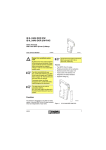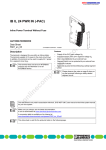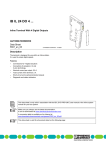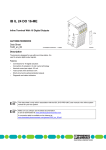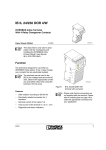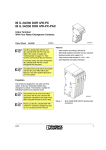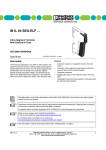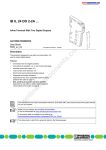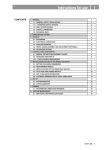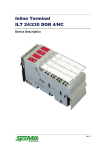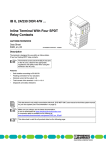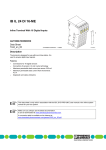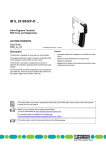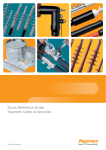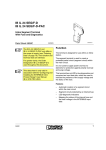Download Data Sheet DB EN IB IL 24/230 DOR 1/W
Transcript
IB IL 24/230 DOR 1/W ... D 1 Inline Terminal With One SPDT Relay Contact R DO 1/W 4x AUTOMATIONWORX Data Sheet 6774_en_00 © PHOENIX CONTACT - 03/2007 Description The terminal is designed for use within an Inline station. It has a floating SPDT relay contact. The terminal can be used in the SELV area and in the AC area. Observe the appropriate regulations and safety notes when using the terminal in the AC area. Features – – – – – Safe isolation according to EN 50178 Floating connection for one actuator Nominal current at the output: 3 A Total current of the terminal: 3 A Diagnostic and status indicators This data sheet is only valid in association with the IL SYS INST UM E user manual or the Inline system manual for your bus system. Make sure you always use the latest documentation. It can be downloaded at www.download.phoenixcontact.com. A conversion table is available on the Internet at www.download.phoenixcontact.com/general/7000_en_00.pdf. This data sheet is valid for all products listed on the following page: IB IL 24/230 DOR 1/W ... Ordering Data Products Description Type Order No. Pcs./Pck. Inline terminal with one digital relay output; without accessories transmission speed of 500 kbps IB IL 24/230 DOR 1/W 2836434 1 Inline terminal with one digital relay output; complete with accessories (connector and labeling field); transmission speed of 500 kbps IB IL 24/230 DOR 1/W-PAC 2861881 1 Inline terminal with one digital relay output; without accessories transmission speed 2 Mbps IB IL 24/230 DOR 1/W-2MBD 2855910 1 Inline terminal with one digital relay output; complete with accessories (connector and labeling field); transmission speed 2 Mbps IB IL 24/230 DOR 1/W-2MBD-PAC 2862110 1 One of the listed connectors is needed for the complete fitting of the terminals IB IL 24/230 DOR 1/W and IB IL 24/230 DOR 1/W-2MBD. Accessories Description Type Order No. Plug, for digital 1, 2 or 8-channel Inline terminals with AC voltage IB IL SCN-8-AC-REL 2740290 Pcs./Pck. 1 Inline spacer terminal block, without accessories IB IL DOR LV-SET 2742641 1 Connector set for spacer terminal block IB IL DOR LV-PLSET 2742667 1 Documentation Description Type Order No. Pcs./Pck. "Configuring and Installing the INTERBUS Inline Product Range " user manual IB IL SYS PRO UM E 2743048 1 "Automation Terminals of the Inline Product Range" user manual IL SYS INST UM E 2698737 1 Technical Data General Data Housing dimensions (width x height x depth) 12.2 mm x 120 mm x 71.5 mm Weight 46 g (without connector), 61 g (with connector) Operating mode Process data mode with 2 bits Connection method for actuators At a floating SPDT relay contact Ambient temperature (operation) -25°C to +55°C Ambient temperature (storage/transport) -25°C to +85°C Permissible humidity (operation/storage/transport) 10% to 95% according to DIN EN 61131-2 Permissible air pressure (operation) 80 kPa to 106 kPa (up to 2000 m above sea level) Permissible air pressure (storage/transport) 70 kPa to 106 kPa (up to 3000 m above sea level) Degree of protection IP20 according to IEC 60529 Connection data for Inline connector Connection method Spring-cage connection Conductor cross-section 0.2 mm2 to 1.5 mm2 (solid or stranded), 24 - 16 AWG Interface Local bus 6774_en_00 Through data routing PHOENIX CONTACT 2 IB IL 24/230 DOR 1/W ... Transmission Speed IB IL 24/230 DOR 1/W, IB IL 24/230 DOR 1/W-PAC 500 kbps IB IL 24/230 DOR 1/W-2MBD, IB IL 24/230 DOR 1/W-2MBD-PAC 2 Mbps Power Consumption 500 kbps Communications power 7.5 V DC 7.5 V DC Current consumption at UL 60 mA, maximum 90 mA, maximum Power consumption at UL 0.45 W, maximum 0.675 W, maximum 2 Mbps Supply of the Module Electronics and I/O Through Bus Coupler/Power Terminal Connection method Through potential routing Relay Output Number 1 Contact material AgSnO2, hard gold-plated Contact resistance 50 mΩ at 100 mA/6 V Limiting continuous current (at maximum ambient temperature) 3A Maximum switching voltage 253 V AC, 250 V DC Maximum switching power (AC/DC) 750 VA (see derating) Minimum load 5 V; 10 mA Switching current at 30 V DC 3A Switching current at 250 V DC 0.15 A Switching current at 253 V AC 3A Maximum inrush current peak for lamp loads and capacitive loads 6 A for T = 200 µs See also Table "Maximum Switching Current for Ohmic Load Depending on the Switching Voltage" on page 4. Nominal power consumption of the coil (at 20°C) 210 mW from the 7.5 V supply Resistance of the coil (at 20°C) 119 Ω ±12 Ω Maximum switching frequency (without load) 1200 cycles/minute Maximum switching frequency (with nominal load) 6 cycles/minute Response delay 5 ms, typical Bouncing time 5 ms, typical Release time 6 ms, typical Mechanical service life 2 x 107 cycles Electrical service life 105 cycles (at 20 cycles/minute) Common potentials All contacts floating 6774_en_00 PHOENIX CONTACT 3 IB IL 24/230 DOR 1/W ... Maximum Switching Current for Ohmic Load Depending on the Switching Voltage Switching Voltage (V DC) Switching Current (A) 10 3.0 20 3.0 30 3.0 40 1.0 50 0.4 60 0.3 70 0.26 80 0.23 90 0.215 100 0.2 150 0.18 200 0.165 250 0.155 Load Current (IL in A) as a Function of the Switching Voltage (Uswitch in V) 3 A 2 .5 IL 2 1 .5 1 0 .5 0 1 0 2 0 3 0 4 0 5 0 6 0 7 0 8 0 9 0 1 0 0 1 5 0 U 2 0 0 V 2 5 0 s w itc h 5 6 6 3 A 0 0 4 Power Dissipation 500 kbps 2 Mbps Formula to Calculate the Power Dissipation in the Terminal PTOT = PBUS + (PREL) + PL PTOT = PBUS + (PREL) + PL PTOT = 0.19 W + (0.26 W) + IL2 x 0.05 Ω PTOT = 0.33 W + (0.26 W) + IL2 x 0.05 Ω For an N/C contact, the term PREL is omitted from the formula. Where PTOT PBUS PREL PL IL Total power dissipation in the terminal Power dissipation through bus operation Power dissipation of the relay coil Power dissipation through the load current via the contacts Load current of the output 6774_en_00 PHOENIX CONTACT 4 IB IL 24/230 DOR 1/W ... Power Dissipation of the Housing Depending on the Ambient Temperature PHOU = 1.2 W -25°C (-13°F) < TA £ +25°C (+77°F) PHOU = 1.2 W - (TA - 25°C [77°F] x 0.02 W/°C) PHOU TA +25°C < TA [+77°F] £ +55°C (+131°F) Power dissipation of the housing Ambient temperature Derating When Using the N/O Contact (500 kbps and 2 Mbps) Power Dissipation of the Housing Ambient Temperature TA Maximum Load Current 40°C 0.9 W 45°C 0.8 W 3.0 A 2.6 A 50°C 0.7 W 2.2 A 55°C 0.6 W 1.7 A With an ambient temperature of up to 40°C, a maximum permissible load current of 3.0 A can flow via the N/O contact. Observe the derating at higher temperatures. Safety Equipment None Error Messages to the Higher-Level Control or Computer System None Air and Creepage Distances (According to EN 50178, VDE 0109, VDE 0110) Isolating Distance Clearance Creepage Distance Test Voltage Relay contact/bus logic ≥ 5.5 mm ≥ 5.5 mm 4 kV, 50 Hz, 1 min. Contact/contact ≥ 3.1 mm ≥ 3.1 mm 1 kV, 50 Hz, 1 min. Contact/PE ≥ 3.1 mm ≥ 3.1 mm 1 kV, 50 Hz, 1 min. Approvals For the latest approvals, please visit www.download.phoenixcontact.com. 6774_en_00 PHOENIX CONTACT 5 IB IL 24/230 DOR 1/W ... Safety Notes for Inline Terminals Used in Areas Outside the SELV Area (AC Area) Only qualified personnel may work on Inline terminals in the AC area. Qualified personnel are persons who, because of their education, experience and instruction, and their knowledge of relevant standards, regulations, accident prevention, and service conditions, have been authorized by those responsible for the safety of the plant to carry out any required operations, and who are able to recognize and avoid any possible dangers. (Definition of skilled workers according to EN 50110-1: 1996). The instructions given in the IB IL SYS PRO UM E user manual and in this data sheet must be strictly observed during installation and startup. Correct Usage The terminal is only to be used within an Inline station as specified in this data sheet and in the "Configuring and Installing the INTERBUS Inline Product Range" user manual. Phoenix Contact accepts no liability if the device is used for anything other than its designated use. Dangerous contact voltage Please note that there are dangerous contact voltages when switching circuits that do not meet SELV requirements. Only remove and insert the AC terminals when the power supply is disconnected. When working on terminals and wiring, always switch off the supply voltage and ensure it cannot be switched on again. Installation Instructions and Notes Technical modifications reserved. Install the system according to the requirements of EN 50178. Use grounded AC networks Inline AC terminals must only be operated in grounded AC networks. Read the application description Observe the installation instructions and notes in the IB IL SYS PRO UM E manual, especially the notes on the low voltage area. 6774_en_00 PHOENIX CONTACT 6 IB IL 24/230 DOR 1/W ... Special Features of the Terminal The terminal can be used to switch loads up to 230 V. Please note that the terminal interrupts the potential jumpers UM, US, and GND (24 V area) as well as L and N (120 V/230 V areas). If required, these supply voltages must be resupplied/provided using an appropriate power terminal after the relay terminal. Switching Loads in the 230 V Area To switch voltages outside the SELV area, an AC area must be created according to the installation instructions and notes provided in the application description. Operation on an AC network Operate the terminal from a single phase on an AC network. Switching Voltages That Are Not Available in the Segment A relay terminal can be used to switch voltages that are not available in the segment in which the terminal is located (e.g., switching 230 V AC within a 24 V DC segment). In this case, place a distance terminal before and after the terminal. The isolating distances between the individual areas are thus maintained. See also "Connection Examples" on page 9. 6774_en_00 PHOENIX CONTACT 7 IB IL 24/230 DOR 1/W ... Local Diagnostic and Status Indicators and Terminal Point Assignment Local Diagnostic and Status Indicators Des. D 1 D 1 Color Meaning Green Diagnostics Yellow Status indicator of the output (relay has picked up) Function Identification D O R 1 /W Red with lightning bolt 2 Mbps: White stripe in the vicinity of the D LED Housing/Connector Color Dark gray housing Dark gray connector, without color print Terminal Point Assignment 1 Terminal Points 1.1, 2.1 1.2, 2.2 1.3, 2.3 1.4, 2.4 2 1 .1 1 1 2 .1 1 .2 2 2 2 .2 1 .3 3 3 2 .3 1 .4 4 4 2 .4 6 7 7 4 A 0 0 3 Figure 1 6774_en_00 Terminal with appropriate connector Assignment Not used (no contact present) Relay N/C contact Relay main contact Relay N/O contact Adjacent contacts 1.2/2.2, 1.3/2.3, and 1.4/2.4 are jumpered in the corresponding IB IL SCN-8-AC connector. It is therefore possible to supply several relays of the terminals by using a jumper to transmit the voltage from one terminal to the next. PHOENIX CONTACT 8 IB IL 24/230 DOR 1/W ... Internal Circuit Diagram Other symbols used are explained in the IL SYS INST UM E user manual or in the Inline system manual for your bus system. Local bus OPC Connection Examples UL Connection of an Actuator D 1 D O R 1 1 /W 2 1 1 2 2 3 3 4 4 7376C010 Figure 2 Internal wiring of the terminal points N /C c o n ta c t M a in c o n ta c t N /O c o n ta c t 5 6 6 3 A 0 0 8 Key: OPC Figure 3 Typical connection of an actuator Protocol chip (bus logic including voltage conditioning) LED 1 .2 N /C c o n ta c t 1 .4 N /O c o n ta c t M a in 1 .3 c o n ta c t Terminal point, without metal contact 5 6 6 3 A 0 0 9 Relay Figure 4 Output relay contacts Electrically isolated area I/O area including relay contact isolated from the logic area including the relay coil through "safe isolation" according to EN 50178 6774_en_00 PHOENIX CONTACT 9 IB IL 24/230 DOR 1/W ... Switching Voltages That Are Available in the Segment Switching Voltages That Are Not Available in the Segment 1 B A R D R C L D U L 2 U S 1 D O R 2 1 2 1 1 1 D U M 1 /W P W R 1 2 1 1 1 2 1 1 1 2 1 1 1 2 1 1 1 2 1 1 1 1 2 1 1 2 1 1 1 1 2 1 1 2 1 1 1 IN 1 2 1 1 2 1 2 1 1 1 B A R D R C L D U L U S 1 2 2 2 2 2 2 2 2 2 2 2 2 2 2 2 2 2 2 2 2 2 2 2 2 2 2 3 3 3 3 3 3 3 3 3 3 3 3 3 3 3 3 3 3 3 3 3 3 3 3 3 3 4 4 4 4 4 4 4 4 4 4 4 4 4 4 4 4 4 4 4 4 4 4 4 4 4 4 1 6 7 7 4 A 0 0 7 Figure 5 2 3 D O R 2 1 D U M 1 /W P W R U M B K -T /U 1 3 U M B K -T /U 1 Distance terminals are not required to switch a 24 V channel within a 24 V area or to switch a 230 V channel within a 230 V area. 3 2 1 2 1 2 1 2 1 2 1 2 1 2 1 IN 1 2 2 1 2 1 1 1 1 1 1 1 1 1 1 1 1 1 1 1 1 1 1 1 1 1 1 2 2 2 2 2 2 2 2 2 2 2 2 2 2 2 2 2 2 2 2 2 2 3 3 3 3 3 3 3 3 3 3 3 3 3 3 3 3 3 3 3 3 3 3 4 4 4 4 4 4 4 4 4 4 4 4 4 4 4 4 4 4 4 4 4 4 Example: Switching 230 V AC within a 24 V DC area 24 V DC area consisting of bus coupler and I/O terminals Terminal separated from the 24 V area by distance terminals 24 V area consisting of a power terminal and I/O terminals 6 7 7 4 A 0 0 8 Figure 6 1 2 3 Switching 24 V within a 24 V area 24 V area consisting of bus coupler and I/O terminals Terminal 24 V area consisting of a power terminal and I/O terminals See also "Special Features of the Terminal" on page 7. Also insert distance terminals if you want to switch a 24 V channel within a 230 V AC area. 6774_en_00 PHOENIX CONTACT 10 IB IL 24/230 DOR 1/W ... Interference Suppression Measures on Inductive Loads/Switching Relays Each electrical load is a mix of ohmic, capacitive, and inductive elements. Depending on the proportion of the elements, switching these loads results in a larger or smaller load on the switch contact. In practice, loads are generally used with a large inductive element, such as contactors, solenoid valves or motors. Due to the energy stored in the coils, voltage peaks of up to a few thousand volts may occur when the system is switched off. These high voltages cause an arc on the controlling contact, which may destroy the contact through material vaporization and material migration. This pulse, which is similar to a square wave pulse, emits electromagnetic pulses over a wide frequency range (spectral elements reaching several MHz) with a large amount of power. If sized correctly, these circuit versions do not differ greatly in their effectiveness. In principle, safety equipment should intervene directly at the source of the interference. The following points speak in favor of a load protective circuit: – When the contact is open, the load is electrically isolated from the operating voltage. – It is not possible for the load to be activated or to "stick" due to undesired operating currents, e.g., from RC elements. – Shutdown voltage peaks cannot be coupled in control lines that run in parallel. Today, the majority of contactor manufacturers offer diode, RC or varistor elements that can be snapped on. For solenoid valves, connectors with an integrated protective circuit can be used. To prevent such arcs from occurring, the contacts/loads must be fitted with protective circuits. In general, the following protective circuits can be used: – Contact protective circuit – Load protective circuit – Combination of both protective circuits A B 5 9 7 3 A 0 2 8 Figure 7 6774_en_00 Contact protective circuit (A), load protective circuit (B) PHOENIX CONTACT 11 IB IL 24/230 DOR 1/W ... Circuit Versions A d d itio n a l D e la y P r o te c tin g th e L o a d D io d e D e In d V o L im fin e d u c e d lta g e ita tio n B ip o la r E ffe c tiv e A tte n u a tio n + U L o a d D L o n g Y e s (U D ) N o A d v a n ta g e s /D is a d v a n ta g e s A d - E - C - R - N - L v a n ta g e s : a s y im p le m e n ta tio n o s t- e ffe c tiv e e lia b le o n - c r itic a l s iz in g o w in d u c e d v o lta g e D is a d v a - A tte n u lo a d r e - L o n g d S e r ie s c o n n e c tio n d io d e / Z e n e r d io d e + L o a d U M e d iu m to s h o rt A d v a n ta g e s : - N o n - c r itic a l s iz in g Y e s (U ) Z D N o Z D S u p p r e s s o r d io d e + (~ ) (~ ) U L o a d Z D M e d iu m to s h o rt n ta g e s : a tio n o n ly v ia s is to r e la y Y e s (U Z D ) Y e s D is a d v a n ta g e s : - A tte n u a tio n o n ly a b o v e U Z D A d - C - N - L - S v a n ta g e s : o s t- e ffe c tiv e o n - c r itic a l s iz in g im its p o s itiv e p e a k s u ita b le fo r A C v o lta g e D is a d v a n ta g e s : - A tte n u a tio n o n ly a b o v e U Z D V a r is to r + (~ ) (~ ) L o a d V D R U V D R M e d iu m to s h o rt Y e s (U V D R ) Y e s A d - H - N - S v a n ig h o n u ita ta g e s p o w e c r itic a b le fo : r a b s o r p tio n l s iz in g r A C v o lta g e D is a d v a n ta g e s - A tte n u a tio n o n ly a b o v e U V D R 5 6 6 3 A 0 2 9 6774_en_00 PHOENIX CONTACT 12 IB IL 24/230 DOR 1/W ... RC Circuit Versions RC Series Circuit: A d d itio n a l d e la y P r o te c tin g th e L o a d D e In d V o L im fin e d u c e d lta g e ita tio n B ip o la r E ffe c tiv e A tte n u a tio n A d - H - S - L - R R /C c o m b in a tio n + (~ ) (~ ) M e d iu m to s h o rt R U L o a d R C A d v a n ta g e s /D is a d v a n ta g e s N o v a n F a u ita e v e e a c ta g e s : tte n u a tio n b le fo r A C l- in d e p e n d tiv e - c u r r e n v ia v o e n t c p o w e r s to re lta g e t a tte n u a tio n o m p e n s a tin g Y e s D is a d v a n ta g e s : - E x a c t s iz in g r e q u ir e d - H ig h in r u s h c u r r e n t C 5 6 6 3 A 0 3 0 Sizing: • • C ≈ LLoad/4 × RLoad2 R ≈ 0.2 × RLoad Capacitor: Resistor: RC Parallel Circuit With Series Diode A d d itio n a l d e la y P r o te c tin g th e L o a d D e In d V o L im fin e d u c e d lta g e ita tio n B ip o la r E ffe c tiv e A tte n u a tio n A d - H - L - C R /C c o m b in a tio n w ith d io d e + (~ ) (~ ) U L o a d R C M e d iu m to s h o rt C A d v a n ta g e s /D is a d v a n ta g e s N o Y e s v a n ta g e s : F a tte n u a tio n v ia p o w e r s to r e e v e l- in d e p e n d e n t a tte n u a tio n u r r e n t in v e r s io n n o t p o s s ib le D is a d v a n ta g e s : - E x a c t s iz in g r e q u ir e d - O n ly s u ita b le fo r D C v o lta g e R 5 6 6 3 A 0 3 1 Sizing: • • Capacitor: Resistor: 6774_en_00 C ≈ LLoad/4 × RLoad2 R ≈ 0.2 × RLoad PHOENIX CONTACT 13 IB IL 24/230 DOR 1/W ... Switching AC/DC Loads Switching Large AC Loads Switching Large DC Loads When switching large AC loads, the relay can be operated up to the corresponding maximum values for the switching voltage, current, and power. The arc that occurs during shutdown depends on the current, voltage, and phase relation. This shutdown arc switches off automatically the next time the load current passes through zero. In DC operation, a relay can only switch a relatively low current compared with the maximum permissible alternating current. This maximum DC value is also highly dependent on the voltage and is determined in part by design conditions, such as the contact distance and contact opening speed. In applications with an inductive load, an effective protective circuit must be provided, otherwise the service life of the system will be reduced considerably. The corresponding current and voltage values are shown using the example in Figure 8. 1 0 0 0 V To prolong the life of the terminal as much as possible when using lamp loads or capacitive loads, the current peak must not exceed 6 A when the load is switched on. U 1 0 0 1 0 1 0 .1 A 1 0 1 I 5 6 6 3 A 0 1 3 Figure 8 DC load limit curve (REL-SNR-1XU/G 5 GOLD LIEG relay) I Switching current in A U Switching voltage in V Definition of the load limit curve: For 1000 cycles, no constant arc should occur with a burning life > 10 ms. A non-attenuated inductive load further reduces the values for switching currents given here. The energy stored in the inductance can cause an arc to occur, which forwards the current via the open contacts. Using an effective contact protection circuit, virtually the same currents can be switched as for an ohmic load and the service life of the relay contacts is the same. If it is permitted to switch higher DC loads, several relay contacts can be switched in parallel. The technical data for this is available on request. 6774_en_00 PHOENIX CONTACT 14 IB IL 24/230 DOR 1/W ... Programming Data Local Bus (INTERBUS) ID code BDhex (189dec) Length code C2hex Process data channel 2 bits Input address area 0 bits Output address area 2 bits (only bit 0 is occupied) Parameter channel (PCP) 0 bits Register length (bus) 2 bits Other Bus Systems For the programming data/configuration data of other bus systems, please refer to the corresponding electronic device data sheet (e.g., GSD, EDS). Process Data Assignment of the Terminal Points to the OUT Process Data (Byte.Bit) view Terminal Status indicator Bit N/C contact Main contact N/O contact LED 0.1 – – – 0.0 1.2 1.3 1.4 1 If bit 0.0 is set to 1, the N/O contact is closed. The LED lights up if the N/O contact is closed. © PHOENIX CONTACT 03/2007 6774_en_00 PHOENIX CONTACT GmbH & Co. KG • 32823 Blomberg • Germany Phone: +49-(0) 5235-3-00 • Fax: +49-(0) 5235-3-4 12 00 www.phoenixcontact.com 15















